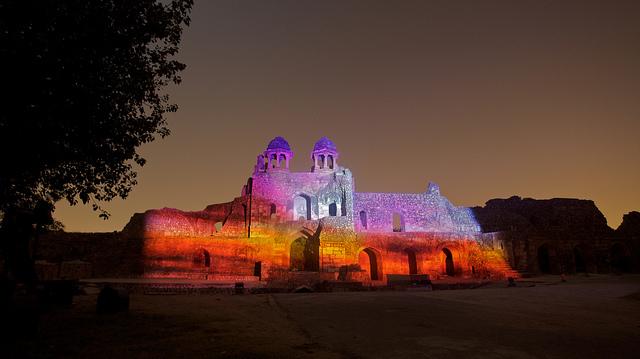
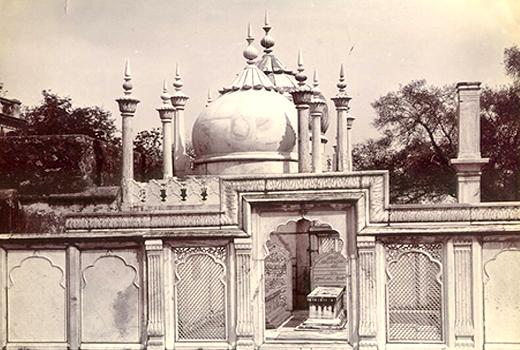
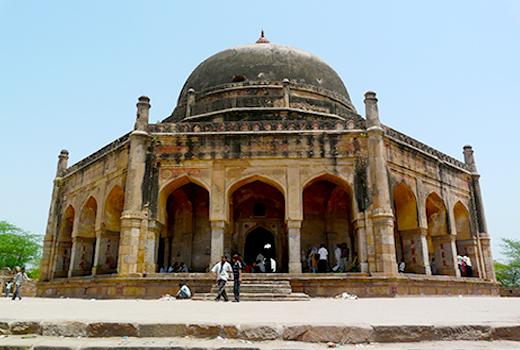
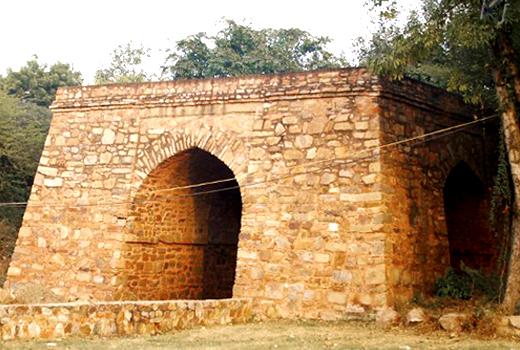
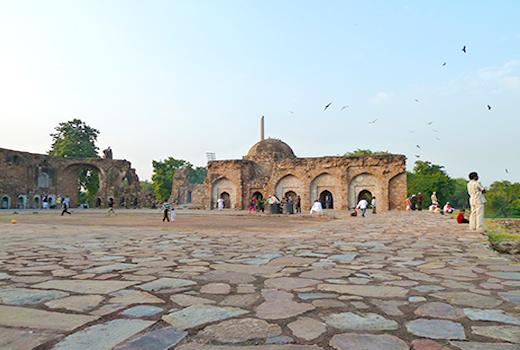
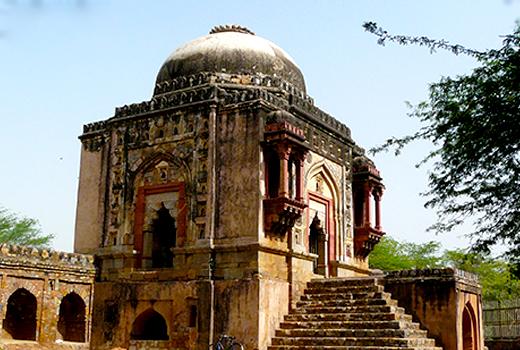
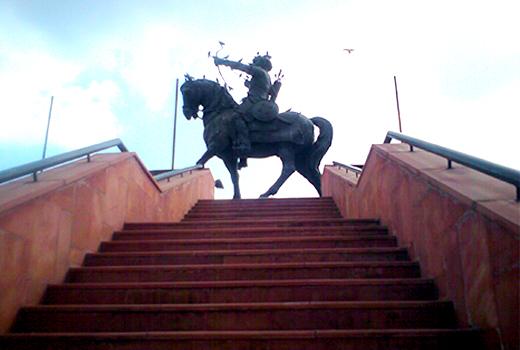
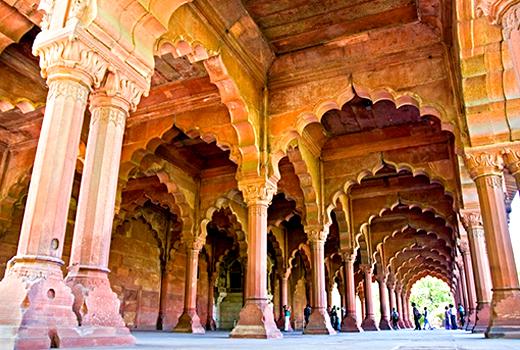
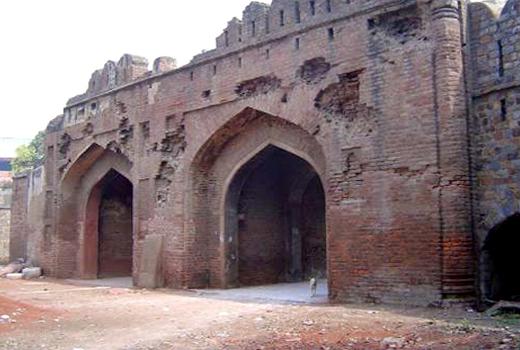
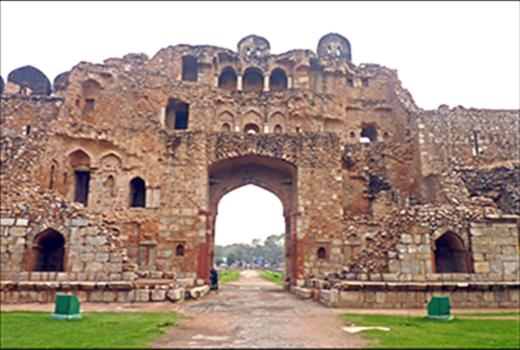
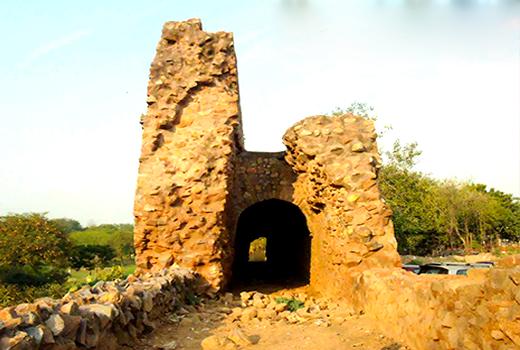
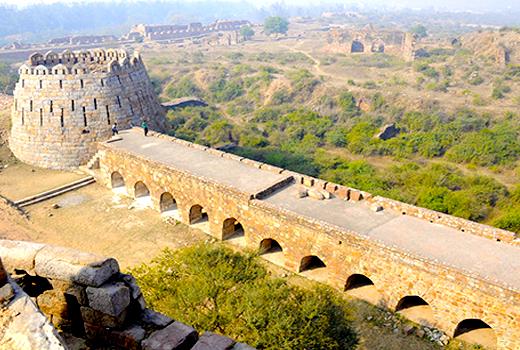
On the fringe of the Gangetic Plain, where the river Yamuna flows towards the south east, arose in last 3000 years of recorded history, the city of Delhi, where amidst rock and desert, forest and river generations of vanquisher men of religion, artist and literary left their mark. The city of Delhi changed many a times, and the cycle of earth shaking events only confirmed the fame of Delhi, as the seat of power in all of India.
Explore the capital city of Republic of India that had been the seat of power of several empires. Explore the podium that held the succession of might since the days of Khandava Forest to the Lutyens' Delhi, which is still doing the same in its present time. Live the vibes, lingering for eons, when the city started building its walls for the City of Lord Indra, and celebrated as Indraprastha, the capital of Pandavas – the legendary characters of the ancient Indian epic Mahabharata. Find yourself back in time of the mythos in Purana Quila, which bears strong believe that the fort has been built over the ancient capital of the opulent and legendary Indraprastha. Feel the depth of your root, as you stand amidst the vast and aging structures of the fort, facing the undated temple, called the Kunti Temple – revered as the temple of the mother of the Pandavas, Kunti, who once lived here. As you absorb the essence of your entity and existence, in between the half fallen structures, behold, for you will be standing in the first city of Delhi, which used to be known as Indrapath up till 1913. From the antiquity, till modern time, this landscape has suckled seven different cities in the recorded history of cultural shift of the Mauryan, Sunga, Kushana, Gupta, Rajput, Sultanate, and British.
It will be a journey back to 5000 years, as you will discover yourself in the oldest structure in Delhi – the Purana Quila, which could never, outgrew the legend of Indraprastha. Remnants of the past still live cheek-by-jowl with skyscrapers, residential colonies and bustling commercial complexes, which have turned the city to a 21st century destination. Experience the mystery, magic and mayhem in the city of Djinns, which now shelters 25 million souls. Explore the distant cousin of the eastern Rome, as wander the streets of India’s capital, which is weighed down with the relics of lost empires. The succession of armies stormed across the city on Indo-Gangetic plain and imprinted their marks onto this vanquished city, as they vanished into the rubbles and ruins like the conquerors that preceded them. Modern Delhi will offer you her cacophonous tapestry of medieval fortifications, Mughal mausoleums, dusty bazaars, colonial-era town planning, and mega malls, all in the rhythm of the changing time.
As you visit the city, do not rush; rather give the city a chance to let you fall in love her with sublime self. Let the lesser-known corners of the city enthrall your spirit. Capture the most rewarding times in the city as you spend time in the Lodhi Garden at dusk. A medieval evening at Nizamuddin Awulia, while immersing into the mysticism of the Sufi Songs, and other city trails in Old Delhi or a Cycle Rickshaw tour along the Yumuna. In time, the cities of Delhi have moved up in number with the construction of the Satellite Cities like Noida, Faridabad, Ghaziabad and Gurgaon, making it a city of 12 cities, known as New Delhi & NCR (National Capital Region), which also, includes the Lutein’s Delhi. The gleaming transit of metro railways and fast lane roadway connectivity depict a very different and futuristic landscape of the city, which had marched on with the ticking time of Khandaprastha to New Delhi & NCR.
It is easy to spend a day of quality time, while visiting some of the finest museums in the country, here in Delhi, and fathom the essence of curation in the myriad meadows of observation. Its boutiques, handlooms and shopping arcades are famous, across the nation and will offer access to a wealth of traditional and contemporary crafts from all over the country. Indulge a day in the potpourri of specialty restaurants to treat your taste buds, open parks and gardens ablaze with flowers to relax and rejuvenate, and especially in the winter months, a variety of cultural events to hang around. Its many-layered existence is tantalizing and can entice the curious traveller in you into a fascinating journey of discovery.
All that are so posh and chick, have never been the contemporary upshots. These are rather the labour of the eon of history that defined the place to be the seat of the power of India from its antiquity to the recent time. These shifts of power can be stressed back to the first millennium BC, which can offer you a much-older and richer past of 3000 years old. While exploring the seven layers - the seven cities of Delhi, much of its antique past, attached with the epic saga of Mahabharata will put you in the oblivion, created by the modern civilization, during the thousand years of ruling of the Muslims and British. The labyrinth of roads, streets, lanes and by lanes, holding the morass of concrete jungle, which has eventually claimed the natural landscape of Delhi in the most baffling way, will hardly give you any trace of the Great Crossing Place of the Yugas, this place had held. Take a trail of the other cities of Delhi like Lal Kot, the core of the Delhi’s first city, built by the Tomar Rajputs. Further, tread to the extended part of this city, created by Prithviraj Chauhan, as the Qila Rai Pitbora.
Travel in the ebb and flow of time as you visit the time of Qutb ud din Aibak, who crowned himself as the Sultan of Delhi and occupied the Rajput fort. To commemorate his victory, he built the Quwwat ul Islam mosque, which is the earliest extant mosque in India, within whose courtyard stands the 4th Century standard of Lord Vishnu, the famous uncorroded Iron Pillar, and nearby its premises, he raised the towering minaret, where you can spend half a day, studying the details of the Qutub Minar, one of Delhi's prevalent landmarks. While, you visit the minaret, don’t miss the other architectural gems, adjacent to the site, the tomb of Iltutmish and the Alai Darwaza.
As you climb down the calendar of years, explore the city built by Allaudin Khilji around 1311. This is the second city of Delhi, known as Siri, with a vast reservoir, now resides at Hauz Khas in dilapidated remains. However, you will have the chance to view this old city, as it has been extensively renovated a few decades later at Hauz Khas. However, the charm of the old city will come with a bouquet of ethnic boutiques and cafes, dotting the Hauz Khas village, making the place an attractive location of the exquisite goods on sale. Here, you can spend a lovely afternoon, followed by an eventful evening in the vicinity of the Siri.
Not far from this place, explore the city built by the most whimsical ruler of medieval India, Muhammad Bin Tughlaque, his great fort of Tughlaqabad, raised in 1321, as a protection against the Moghul invention, which became the third city of Delhi. Today, the fort lies in ruins, at a vast expanse, by the road, connecting Delhi to Faridabad. Till date, the high-raised foundation of the fortress, blazing like gold under the impossible Sun of Delhi, reflects its robust past that echoes from the fort and tomb, as well. If you happen to spend your entire day, languidly exploring the arches and arcs of the fallen city, here in Tughlaqabad, and bid adieu by evening, look back to one of those pasts of Delhi, to find the citadel glowing with tungsten illuminates – as if the third city of Delhi is still breathing the days of Tughlaque. However, like the first mythical city of Indraprastha, the forth city of Delhi, Jahanpanah has practically been disappeared in the tumultuous historicity of Delhi. Its existence can only be heard, as folklore of this place that had stood and seen the rise and fall of time – in the toil of holding the seat of power, of the nation called India.
In one of the most beautiful gardens of Delhi, you find the time, lingering to whisper to you the tale of the fifth city of Delhi. Close to the National Headquarter of the United Nation Organization, the splendid landscape of Lodhi Gardens beholds the tombs of the Lodhi Kings date to the era of 15th Century that saw a very little growth in the history of Delhi. Basically, the city was raised as Firoz Shah Kotla, now off the Bahadur Shah Zafar Marg, which is famous for its Pillar of Ashoka, which the Sultan brought from Mathura. Nevertheless, during 1398 the city had to bear the misfortune of the invasion Timur that devastated Delhi, and left the city with very less to contribute to the layering history of Delhi. As you walk the line of Delhi’s historicity to venture its sixth city and its chime of victory and valor, the Empire of Mughals in India will pave you to the very beginning of the city.
The impressive Purana Quila, overlooking the romantic Yamuna was the sixth city of Delhi, built by Babur in 1526. Spectacle the quest of Islam, as it is popular amongst the native that the fort of the Mughal Empire in India had been founded on the very site, where used to be the epic city of Indraprastha, the first city from where today’s landscape of Delhi has been germinated. However, as the destiny acted upon the then time, none of the dynasties of that era could finish the fort to flaunt their grandeur. It had been a combination of effort that had tumbled down from Babur to his son Humayun, and while the Afghan king Sher Shah Suri ousted the Mughals; the construction efforts continued on his onus. What was possibly a library is now a fine mosque, resides in the fort. This city, however, will offer you a transit from the mediaeval city to the city of the modern time.
Nearby, you may visit the zoo, the Craft Museum, where you can experience the ambience of the craftsmen working in a simulated rural setting. Off course, if you happen to visit the place during winter time, do not miss to visit Pragati Maidan, the exhibition ground of the city that holds expositions of myriad trades, which reflects the diversifying culture of the nation and its emerging habit towards modernization. The one among those, who tried to build the sixth city on top of the very first, the germination ground of the story of Delhi, now resting in peace 2 km from here, in the magnificent tomb of Humayun, the precursor of the Taj Mahal.
However, the Mughal Empire did not stop here. To experience its continuing legacy, visit one of the most densely populated localities in the world, which retained its unique vitality and charm till date. Welcome to Shahajahanabad, founded by the emperor Shah Jahan in April 1639, epitomizing the pomp and grandeur of the Empire, Delhi’s seventh city. Withstanding all the splendors and sorrows of the time, this walled city has since been inhibited. The Red Fort, Shah Jahan's sandstone citadel, encompassing grand audience halls — where the legendary Peacock Throne once stood — and marble palaces bedecked with exquisite pietra dura. Opposite the Red Fort stands the Jama Masjid, India's largest mosque.
For a gallant traveller Delhi has more... Chandni Chowk, where one can shop possibly everything the city has, is the place, where dwells the moonlit square - adjacent to the mosque, which leads you to the heart of the walled city. This was once a tree-lined bazaar with a canal flowing through its centre. Today, it is one of the largest trading centres in northern India - thriving, congested and chaotic. Chandni Chowk is replete with historical landmarks and each of its by-lanes leads into a world of spices or silver or perfumes or textiles.....
And the eighth city – the very city of Delhi, upon which all these had happened, is rather known as New Delhi, which was built in 1911, as the capital of British India was shifted from Calcutta to New Delhi. With all its past, the ancient city became the new imperial capital of British, a sprawling metropolis that remained to be the political centre of India, New Delhi. It was to be conceived with spaciousness and care so that the new creation would be in every way worthy of this ancient and beautiful city. Lutyens and Baker planned a city with wide, tree-lined avenues. And with all its grand buildings, one still have a place of pride, the 340-roomed Viceroy’s Palace, now the Rashtrapati Bhawan, raised on Raisina Hill, facing the first city of Delhi – Indraprastha and to the North, the last city of the Mughals - Shajahanabad. It will be a feast to your senses to visit this palace of the then Viceroy of India, but on whose retreat, less than 17 years of its completion, the symbol of an Empire metamorphosed to Government House. This house reflects the dedication of Lutyen’s entire life, which he kept on devoted, until he became bankrupt. Architecturally, you can view the beauty of all of India in this single house, rather palace.
Nearby the Rashtrapati Bhawan are India Gate, a World War I memorial, Parliament House, the prestigious National Museum and the National Gallery of Modern Art. On Republic Day, Rajpath witnesses a display of pomp and heritage of the nation’s strength and dedication to its sovereignty. It would be an experience of a lifetime, if you be there on 26th of January. The classy commercial centre of Connaught Place was planned as part of New Delhi. Along with stalls on Janpath, and emporia on Baba Kharak Singh Marg, it is a shopper's paradise. Rather characteristically, an 18th century masonry observatory, the Jantar Mantar, lies amidst the commercial area. Nevertheless, there is still more to Delhi. Its art galleries and theatres and a variety of museums, memorials to leaders, Hindu, Sikh, Buddhist, Jain and Bahai temples, folk dancers, discotheques, urban villages, and even bird watching along the ridge. Discover the spirit of the country, in the city of Delhi, the city of seven cities.
Are you interested to know more about the unbroken mind of Delhi to its cultural continuity?
Let us hear from you at +91 33 4046 4646
Duration: 05 Nights & 06 Days
Destination: Delhi – Agra – Fatehpur Sikri – Jaipur
Day 1: Arrive Delhi
Arrive at Delhi, and be assisted at the airport or railway station and transfer to the hotel. Night stay in Delhi
Day 2: Delhi
After breakfast proceed for city sightseeing tour of Old and New Delhi
OLD DELHI - A sight-seeing tour of Old Delhi would include visiting the Raj Ghat - the memorial site where Mahatma Gandhi was cremated; Jama Masjid - the largest mosque in India.
NEW DELHI - An extensive sight-seeing tour of New Delhi would include a visit to the Qutub Minar, a drive along the ceremonial avenue - Rajpath, past the imposing India Gate, Parliament House, and the President's Residence and would end with a drive through the Diplomatic Enclave. Night stay in Delhi
Day 3: Delhi – Agra (By Surface)
After breakfast drive to Agra. Arrive Agra and check in at your hotel. Later, proceed for city sightseeing tour of Agra. Visit the world famous Taj Mahal, built by the Mughal Emperor Shahjehan in 1630 for his queen Mumtaz Mahal to enshrine her mortal remains. Also visit Agra Fort, containing the pearl mosque – the rusty and majestic red sandstone fort of Agra stands on the bank of river Yamuna and Emperor Akbar started the construction in 1566. At the Diwan-I-Khas (Hall of Private Audience) the marble pavilions with floral inlays lend on ethereal ambience, the Emperor sat on his gem-studded peacock throne and met foreign ambassador and rulers of friendly kingdoms. Night stay in Agra
Day 4: Agra – Fatehpur Sikri – Jaipur (By Surface)
After breakfast drive to Jaipur en-route visit Fatehpur sikri, a perfectly preserved red sandstone “ghost town” which was the estranged capital of Mughal emperor Akbar, built in 1569 and deserted when its water supply failed. After the visit continue drive to Jaipur. Arrive Jaipur and check-in at hotel. Night stay in Jaipur
Day 5: Jaipur
After breakfast proceed for excursion to Amber Fort.
AMBER FORT PALACE - Amber is the classic romantic Rajasthani fort palace. Its construction was started by Maharaja Man Singh I in 1592, and completed by his descendent Maharaja Jai Singh I. Its forbidding exterior belies an inner paradise, where a beautiful fusion of Mughal and Hindu styles finds its ultimate expression.
CITY PALACE - A delightful blend of Mughal and traditional Rajasthani architecture, the City Palace sprawls over one-seventh of the area in the walled city. It houses the Chandra Mahal, Shri Govind Dev Temple and the City Palace Museum.
JANTAR MANTAR - This is the largest and the best preserved of the five observatories built by Jai Singh II in different parts of the country. This observatory consisting of outsized astronomical instruments is still in use.
HAWA MAHAL - The ornamental facade of this "Palace of Winds" is a prominent landmark in Jaipur. Their five-storey structures of sandstone plastered pink encrusted with fine trelliswork and elaborate balconies. The palace has 953 niches and windows. Built in 1799 by Maharaja Pratap Singh, the Mahal was a royal grandstand for the palace women. Night stay in Jaipur
Day 6: Departure
Morning, proceed for departure and transfer to the airport or railway station to board the flight or train for your onward journey. Tour ends with sweet memories.
For assisted tour booking and customization according to your requirement, please call: +91 33 4046 4646
Inclusions
Exclusions
Important Note: The above given cost is calculated on the basis of the selected hotels and base or mentioned category of rooms. In case Rooms in the above said hotels are not available at the time of booking then we will offer similar category hotel and the costing is subject to change as per the rates & availability of rooms. Please note that this is our offer letter and we are not holding any rooms in the above said hotel as of now. We will process the booking upon your receipt of your confirmation
Hotels foreseen or similar
|
Cities |
Standard 2 Star |
Superior 3 Star |
|
Delhi |
Delhi Pride |
Le Seasons |
|
Agra |
Amar Yatri Niwas |
Crystal Inn |
|
Jaipur |
Garden View |
Vrisa |
Tour Cost (INR): Valid till 30th September 2015
|
Particular |
Standard 2 Star |
Superior 3 Star |
|
Per person in a twin / double sharing plan |
Rs. 19500/- |
Rs. 21500/- |
Tour Cost (INR): Valid from 1 October till 31 March 2016 (except 20 December 2015 till 5 January 2016)
|
Particular |
Standard 2 Star |
Superior 3 Star |
|
Per person in a twin / double sharing plan |
Rs. 20400/- |
Rs. 23200/- |
As suggested and to be customized as per request

Tour Conditions
Our Company Cancellation (Retention) Policy
Hotels cancellation (charges) policy – as per their company policy
Note
 Loading..
Loading..